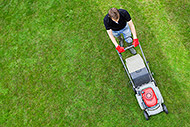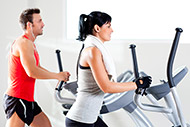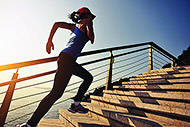
There are more ways to incorporate stretching than you may think. Exercise timing, your fitness environment, and your training goals all influence which type of stretching is best for you. All forms of stretching improve flexibility and range of motion. The American College of Sports Medicine (ACSM) lists the following five types of stretches.
Static Stretching
Static stretching is most often recommended for general fitness. With this type, you slowly ease into the position and hold for 10 to 30 seconds before slowly releasing the stretch. Static stretching should be performed with warm muscles, such as after a warm-up or at the end of a workout. There are two forms of static stretching.
Active Static: This form of stretching is used in yoga and martial arts. The stretch is held by the strength of agonist muscles (muscles responsible for the movement). Think of the stretch across the upper body during the Warrior II pose in yoga. Your arms are extended as your back, chest, and shoulders are stretched. The muscles of the arms and shoulders are the agonist muscles that allow you to hold this stretch.
Passive Static: During this type of stretching, you hold the limb to perform the stretch without any assistance such as a bar or bands. Think of a standing quadriceps stretch in which you bend your leg behind you and hold the foot, pulling the heel in close to your bottom, which stretches the front of the upper thigh.
Dynamic Stretching
Dynamic stretching is stretching with movement. The body transitions gradually into a position, and this movement is repeated as you increase your reach and range of motion. If you have ever taken a group exercise class, you have likely engaged in dynamic stretching. Movements, such as alternating knee lifts, repeatedly stretch the hamstrings while keeping the body in motion. Research has found that dynamic stretching is less beneficial than static stretching for increasing range of motion, but unlike static stretching, it is ideal during the pre-workout phase because it gently warms muscles while also stretching them.
PNF Stretching
PNF stands for Proprioceptive Neuromuscular Facilitation. This type of stretching is often referred to as partner stretching because two people are needed to perform the movements. There are many forms of PNF, but most involve an isometric hold followed by a static stretch of the same muscle group. An example of PNF is a hamstring stretch where one person lies on her back with the right leg extended straight up into the air. The second person grasps the ankle and gently presses the leg towards the other person’s head to stretch the hamstring. The pressure is released and then the stretch is repeated.
While PNF is as effective as static stretching for improving range of motion, it is less practical because of the necessity of a partner. It is most often used in clinical and fitness settings for training and rehabilitation.
Ballistic Stretching
This type of stretching uses bouncing movements to create momentum which moves the muscle into the stretch. For example, instead of holding a hamstring stretch, you would quickly reach towards your toes and release repeatedly in short bursts of movement. Fitness trainers have long been warned about the dangers of ballistic stretching because it can cause a stretch reflex that injures the muscle. Current recommendations from the ACSM state that ballistic stretching can improve flexibility as well as static stretching when it is performed properly. It is best considered for those participating in ballistic exercises such as basketball and other athletics.



 5 Ways to Burn 300 Calories this Weekend
5 Ways to Burn 300 Calories this Weekend
 The Best Home and Garden Chores for Burning Calories
The Best Home and Garden Chores for Burning Calories
 5 Tips for Making Exercise a Habit
5 Tips for Making Exercise a Habit
 Best Ways to Stay Safe during Exercise in Hot Weather
Best Ways to Stay Safe during Exercise in Hot Weather
 11 Tips for Exercise Motivation
11 Tips for Exercise Motivation
 Signs You Need to Increase Exercise Intensity
Signs You Need to Increase Exercise Intensity
 Mistakes to Avoid When Setting Fitness Goals
Mistakes to Avoid When Setting Fitness Goals
 Essential Gear for Starting an Exercise Program
Essential Gear for Starting an Exercise Program

 Pinterest
Pinterest RSS Feed
RSS Feed